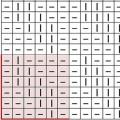Patterns for knitting a scarf. Scarf with an openwork pattern and a wide border How to knit a beautiful border for a scarf
Size: 179 cm x 51.5 cm
You will need: yarn (55% wool, 33% polyacrylic, 12% cashmere; 118 m/50 g) – 350 g sand; hook No. 5; circular knitting needles № 5,5.
Crochet Border: knit according crochet pattern, while rotating the rows according to pattern using 2 or 3 vp. rise. Perform rows 1–8 11 times, doing arches in rows 4–7 at the same time. Then for the corner, perform rows 1–5 once, then perform rows 9 and 10 once. Next, starting from the 3rd row, continue to knit the border at a right angle, while doing rows 3–8 once, then doing rows 1–8 10 times, as indicated at the beginning of the pattern, finishing according to. pattern with rows 1–7. Attention: for clarity, every 2nd row is highlighted in color.
Pattern 1: garter stitch = knit and purl rows – knit stitches.
Short rows: start on middle 7 marked stitches. Knit the loops, then turn the work and remove the 1st loop with 1 yarn over, like a purl, while pulling the thread tightly back, knit the marked loops, turn the work, slip 1 loop with 1 yarn over, like a purl, and knit back, while yarn over knit the previous row with the next loop together. Starting from the 3rd row, constantly include 2 more loops in the work on both sides at the end of each row, only after that turn the work, constantly remove the 1st loop with 1 yarn over, like a purl, and in the next row knit the yarn over together with next loop. So the number of loops within 2 rows constantly increases by 4 stitches.
Knitting density: pattern 1 – 16.5 p. x 35 r. = 10 x 10 cm; border – width 9.5 cm.
Attention: The dimensions on the pattern were obtained by measuring the model.
Description of work: perform a chain of 8 v.p. and 3 v.p. rise and tie the border. The link of the last stitch of the crocheted border forms the 1st stitch with knitting needles (= edge stitch). From here, on circular knitting needles, cast on stitches along the inner side edge of the border as follows: * 1 yarn over, while skipping 1 row of border, from ch. lifting the next crocheted row, cast on 1 loop, from * constantly repeat, finish with 1 yarn over and then, along the initial row of the border, cast on 1 more edge = 187 stitches, with the yarn overs counting as one loop. In the next purl row, start with 1 edge, * knit 3 loops from the yarn over (= 1 knit, 1 purl, 1 knit), purl the next loop, repeat from * another 91 times, finish by knitting 3 loops and 1 edge = total 373 p.
Then knit pattern 1 on all loops, while in the 2nd row, evenly distributed, decrease 78 sts = 295 sts. Mark the middle 7 sts at the top and then continue working in shortened rows. After 42 cm = 146 rows from the beginning, all the loops are in the work. Then loosely bind off all the stitches like knit stitches.
Rainbow bactus" Openwork leaves"!
I knitted my first bactus “Rounded Leaves”, increasing/decreasing every 6th row.
This time I wanted the bactus wider than the previous one, so at the beginning and at the end I added/decreased it on one side in front of the border in every 6th row (1/4 of the length), and in the central part in every 4th row.
I knitted it from Cascade Yarns Fixation yarn (98% cotton, 2% elastic, 50 g/91 m) - the shawl took 3.5-4 balls, 4.5 mm knitting needles.
Dimensions: 139 cm x 32 cm (center with border)
I cast on about 16 loops.
To make it not boring, I, as usual, added a transverse border of leaves.
22 leaves - one side.
I took the border from the book Barbara Walker for 10 loops -
1st row: remove 1 stitch, knit 2, yarn over, knit 2 together, * yo - 2 times, knit 2 together, yarn over - 2 times, knit 2 together, knit 1*
2nd row: *remove 1 stitch, (2 knits, purl 1) - 2 times* (purl in the 2nd turn of the yarn over of the previous row), knit 2, yarn over, knit 2 together, knit 1 .
3rd row: remove 1 stitch, knit 2, yarn over, knit 2 together, knit 2, *yo - 2 times, knit 2 together, yarn over - 2 times, knit 2 together, knit 1*
4th row: *remove 1 stitch, (2 knits, purl 1) - 2 times*, k4, yarn over, knit 2 together, knit 1.
5th row: remove 1 stitch, knit 2, yo, knit 2 together, knit 4, *yo - 2 times, knit 2 together, yo - 2 times, knit 2 together, knit 1*
6th row: *remove 1 stitch, (2 knits, purl 1) - 2 times*, knit 6, yarn over, knit 2 together, knit 1.
7th row: remove 1 stitch, knit 2, yo, knit 2 together, knit 6, *yo - 2 times, knit 2 together, yo - 2 times, knit 2 together, knit 1*
8th row: *remove 1 stitch, (2 knits, purl 1) - 2 times*, knit 8, yarn over, knit 2 together, knit 1.
9th row: slip 1 stitch, knit 2, yo, knit 2 together, knit 8, *yo - 2 times, knit 2 together, yo - 2 times, knit 2 together, knit 1*
10th row: *remove 1 stitch, (2 knits, purl 1) - 2 times*, 10 knits, yarn over, knit 2 together, knit 1.
11th row: remove 1 stitch, knit 2, yarn over, knit 2 together, knit 15.
12th row: cast off 10 stitches, knit 6, yarn over, knit 2 together, knit 1.
Repeat rows 1-12.
Bactus "Rounded leaves".
Bactus is a small triangular shawl knitted crosswise.
Most often they knit in garter stitch (all rows are knit), increasing/decreasing in every 4th row on one side. For a larger shawl-shawl (you will need about 400m of yarn) the width in the center will be about 50-56 cm.
But I decided to make a whole set - a bactus and a hat from 5 balls of Cascade Yarns Fixation (98% cotton, 2% elastic, 50 g/91 m) - the shawl took 270-280 m = 3 balls, 4.5 mm knitting needles.
I am very pleased with the yarn - very pleasant to the touch, like terry towel!
So I cast on 8 stitches, and then added/decremented 1 stitch in every 6th row on one side in front of the border - I got a triangular scarf.
Dimensions: 160 cm x 23 cm (center)
If you want a wider bactus, then you can add/subtract at the edges in every 6th row (1/4 of the length of the product), and in the center add/subtract in every 4th row... You will get a width of 32-38 cm, in depending on the length of the product.
To make it not boring, I added a transverse border of leaves (the border is very popular - I saw it in 3-4 collections of patterns)!
15 leaves - one side. Only 30 leaves!
I knitted it in 4 pm - about 8 hours in total...
I decided to make it simple, but my own. Please use it!
http://vyazalochki.ucoz.ru/publ/obv...jma/106-1-0-150


In the diagram, circles indicate yarn overs, and triangles indicate a knit loop knitted from a crossed broach. Vertical lines are knit stitches, horizontal lines are purl stitches.
Knitting patterns -- Leaf motifs -- Leaf chain
Legend
I - front
- - purl
O - yarn over
\ - 1 pull through (slip 1 loop, knit the next loop and pull the removed loop through it)
/ - knit 2 together
M - 3 knit together
W - knit three from one loop (knit 1, yarn over, knit 1)
Legend
I - front
- - purl
O - yarn over
/ - knit 2 together
& - cast off 1 stitch
The description of the pattern is taken from the magazine. The Apple tree leaves border is knitted using size 3 needles from acrylic yarn. Knitting pattern for a beautiful border
The yarn I chose was not the thinnest: 50 g / 165 m (100% cotton). I knitted with knitting needles No. 2 and No. 2.5. A satin ribbon also came in handy.
I found it on the Internet interesting scheme borders with leaves (I just changed it a little). I started knitting with her.
I knitted the leaves more thin knitting needles (№ 2).
Squares gray we skip them in the diagram (they don’t seem to exist).
You need to cast on 9 loops on the knitting needles and knit 1 row: edge, purl, knit, yarn over, knit, yarn over, knit, purl, then an edge of 2 loops, which we knit in garter stitch (knit stitches in knit and purl rows ), we complete the row of front edging.
The 2nd row and the rest of the purl rows are knitted according to the pattern (how the stitches look).
In the 3rd row a loop appears called an increase.
We knit it like this: we pick up the thread from the broach in the right place with the right knitting needle, twist it and transfer it to the left knitting needle. Then we knit it purlwise.
Continue knitting according to the pattern. Having knitted all 18 rows of the pattern, bind off the first 6 loops in the next row. There are 9 loops left on the knitting needle. Start knitting the pattern again from the 1st row according to the pattern. And so on.
When you knit the last leaf, you do not need to knit the stem for the next leaf. Finally, bind off all the loops.
I knitted a border of 6 leaves according to the given pattern. This is half of the collar. The second half should be knitted according to the pattern in the reverse order of stitches, that is, start with an edge stitch and 2 stitches in garter stitch.
When both ribbons with leaves are connected, the bases of the first leaves must be carefully sewn together.
Then you need to put our knitting on long knitting needle and knit a mesh pattern.
Because the spokes suitable length I only had bigger size(No. 2.5), then instead of 2 yarn overs I knitted 1, and in the next row I knitted 2 loops from it (as it should be according to the pattern).
Yarn (53% silk, 43% cotton, 4% polyester; 110 m/25 g) - 200 g sulfur; knitting needles No. 3; hook No. 2.5.
Patterns and schemes
Facial surface
Front rows - front loops, purl rows - purl loops. In circular rows, knit all stitches.
Openwork pattern
Rows 1–4: stockinette stitch.5th row: 1 edge, * knit 2 stitches together with a slant to the left (= remove 1 stitch, as in knitting, knit 1, pull the removed loop through it), 1 yarn over, from * constantly repeat, finish 1 edge. Row 6: purl stitches.
Constantly repeat 1–6 rows in height.
Floral pattern
Knit according to pattern A.Start with 6 sts before the 1st arrow, repeat rapport 11 times = 8 sts, finish 3 sts after the 2nd arrow. If the badges are connected at the bottom, then the columns are knitted into 1 base loop. Repeat the 2nd–5th rows 2 times, then knit the 2nd and 3rd rows once.

Openwork pattern
Lace, crocheted: knit according to the given crochet pattern B, constantly repeat the rapport between the arrows. 1st r. perform as a purl row. At the same time, Art. s/n knit into an arch from vp. previous row.All stitches shown above the ch should be worked around the ch. the underlying row. If the badges are connected at the bottom, then the columns are knitted into 1 base loop.

Knitting density
28 p. x 34 r. = 10 x 10 cm, tied openwork pattern knitting needles No. 3.Completing of the work
Cast on 97 sts on needles, knit 1 purl. R. purl, then knit in an openwork pattern.After 180 cm = 552 rub. knit another 4 r. stockinette stitch, then loosely close all loops.
Assembly
Crochet along the cast-on and secured edge first floral pattern, while performing 1 tbsp in each loop. b/n (= 1st r. of the pattern for the hook).Then, joining, crochet the lace.

Knitted using a scarf http://www.stranamam.ru/post/11826806 /, only now in the second scarf, when knitting the border, I sort of gathered it in the middle of the scarf so that the border lay in a semicircle.
Weight 200 grams, length 150 cm.
tied in two threads




border pattern, from the 5th row knitted in garter stitch

Description of knitting a scarf with a border
Knitting the body of the scarf.
We knit with garter stitch. Make increases and decreases only on one side of the scarf.
1st part of knitting:
1) - cast on 3 loops, knit 2 rows in garter stitch, then increase in every 4th row on one side of the scarf - 13 times. There are 16 loops on the needles
2) -increase every 6th row -11 times. There are 27 loops on the needles
3) - add -12 times in every 8th row. There are 39 loops on the needles.
2nd part of knitting
Knit an even part of 96 rows on 39 loops
3rd part of knitting
When knitting the 3rd part of the scarf, decrease one loop at a time in a mirror image of how you knitted the first part from 3 loops to the middle. There should be 3 loops left on the needles.
4th part of knitting
Cast on loops along the length of the scarf on the side of the scarf where increases and decreases were made to knit a border. On the second part of knitting the scarf, where an equal part of 96 rows is knitted without increases or decreases, distribute the border pattern so that the border is slightly gathered and lies in a semicircle. (see photo of the scarf)
 A man left another girl for me
A man left another girl for me The child has a temperature of 39
The child has a temperature of 39 Relief knitting patterns with diagrams and descriptions Knitting patterns for dark yarn in leaf shape
Relief knitting patterns with diagrams and descriptions Knitting patterns for dark yarn in leaf shape